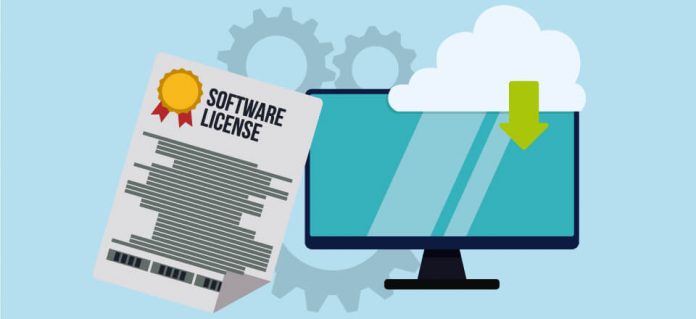This article is written by Lavish Sharma, from Institute of Law, Nirma University. This article discusses software licensing in India including the laws, regulations and the agreements surrounding it. The future of these licensing agreements has also been discussed.
Table of Contents
Introduction
Since the last quarter of a century, the software industry has been one of the fastest-growing industries. It is a low-cost, intellect-intensive industry with low entry barriers and restrictions and a large set of opportunities with the autonomy of the creators. It is usually said that software and hardware are like the two sides of the coin, meaning that they both are interdependent on each other. Hardware is spineless without software as the former is just a piece of metal without the latter, which marks its importance. With the Internet, the software can be delivered anywhere in the world through the Net. Although the software has often been offered as an integral part of the operating system in the past, software products are now commonly marketed, released or approved as computer-readable devices, such as diskettes and CD-ROMs, or directly over the Internet. In India especially the software product market has been the fastest-growing sector out of all the IT services in India in FY2019.
Even after the gigantic setup, this industry has created it still faces a major setback of software piracy i.e. the stealing or copying or torrenting of the software, because of the world of the internet the software which might have taken years to develop can be copied within seconds at a meagre cost and many of times even free. The solution to it or say the legal way out of it to protect one’s created software is Software licensing. Software license provides legal protections linked to licensed usage of the software. Failure to conform to the provisions of the software licensing includes criminal penalties surrounding registered intellectual property (IP) and proprietary content.
Genesis of software licenses in India
With the advancement in the laws surrounding the protection of a person’s creation or the intellectual property, the focus started to increase on the need for the licenses for software. The Copyright Act was enacted in 1957 in India but at the time of commencement no such express provision was mentioned for computer software as for a developer to be protected as an author, but it is after 37 years of the enactment of act i.e. in 1994 that sub-clause (vi) was added under section 2(d) which recognized computer-generated work as work of authors. After these provisions were inserted a new field was developed for the software industry as well as for the lawyers of “software licensing” which created a set of the contractual relationship between the developer and the user through which it created certain rules and regulation for the user as well as for the world at large regarding the usage of a particular software of a developer. This advent of licensing benefited the developers largely protecting their works.
Types of software licenses
Software licenses in India can be comprehensively named proprietary licenses, free software licenses, and open source licenses.
Proprietary software license
IT is a PC software that is authorized by the proprietor of the copyright under quite certain terms. It is the most prohibitive kind of permitting understanding wherein the first code was composed by the software engineers are not accessible to the users.
Along these lines they can utilize the product yet they can’t change it or redistribute it. This product is otherwise called the closed source software and the working of windows and Mac is a case of this software. To ensure their protected innovation, the organizations go into this type of license.

Free software license
These have lesser limitations than the previous one. The product can be unreservedly utilized by the clients to adjust the product, or redistribute it, which would somehow or another be restricted by copyright law. Along these lines, a free programming permit is gone into by the proprietors of the product when they wish to give the beneficiaries the benefit of changing or redistributing the copyrighted work.
Open-source software license
It permits the client to make changes to the product and make the source code accessible or transparent. As it permits different engineers to see the first code, it is typically evolved as an open coordinated effort and made unreservedly accessible.
The permit doesn’t confine any gathering from selling or redistribution of the product as long as the dispersion is made under indistinguishable terms from the permission of the first programming. The General Public License or GNU is a case of an open-source programming permit that was created because of joint effort and exploration of open engineer networks.
Factors affecting licensing provision
What type of software is being licensed
Software licensing is a form of arrangement that happens between the individual that creates the product of software and the end customer, or the individual that owns or downloads the software to be used. It is built to secure the rights of the program and also limits the way the end-user may access it. Most of these limitations consist of duplicating or downloading the program on more than one device. Changing the program in some way or modifying the code is therefore usually forbidden by a software license.
- Proprietary Software – The proprietary software is a computer product that is the legitimate property of one entity. Terms of usage by certain parties are specified through contracts or licensing agreements. Such definitions may provide different protections for exchanging, modifying, disassembling, and accessing the program and its content.
- A free software – The software license is a license that gives users the ability to edit and redistribute software that would otherwise be forbidden under copyright law. A free software license gives users the rights to alter or share patented works in the context of permissions.
- Open Source Software – Open Source Software refers to any application whose source code is made accessible for use or alteration by consumers and made publicly available. Open Source helps people to access and change the source code.
What is the potential market for the software
The tech industry is rapidly developing in India. It is the world’s leading destination for IT and IT facilities. According to NASSCOM, India’s leading supplier of information, gross sales rose from 1.2 per cent in 1997–1998 to 5.8 per cent in 2008–2009.
India is the ideal choice for companies and their market needs. The factors that attract potential investors are India’s vast talent pool, good infrastructure, and low costs. The standard of the services delivered is what powers its industry in India. Most Indian companies are CMM Level 5 certified. The software development sector is a big source of sales. The BPO (Business Process Outsourcing) and KPO (Knowledge Process Outsourcing) industries are expanding with more companies looking to offshore their customer service departments. In addition, newer areas are emerging that are making India a potential investor winner. Technology companies, such as Infosys, Wipro, and TCS, are offering tech applications to overseas customers. In all major Indian cities, IT parks have been developed. In short, Bengaluru is referred to as the Silicon Valley of India. Many MNCs, such as Capgemini and Yahoo, have penetrated the Indian market and are leveraging the massive talent pool in India. As a consequence, the software solution industry is rapidly expanding.
What are the potential risks in distributing the software
The idea of royalty piling stems from the possibility that several patents can affect a single product. Royalty stacking happens because, to put the product into the market, the manufacturer of the software obtains a warrant from all the owners of the patents surrounding the finished product. Once royalty fees are applied up, the licensee can become a non-profitable company. It has, therefore, become quite usual for licensees to insist on including anti-stacking provisions in licensing agreements. A typical anti-stacking provision states that the royalty rate payable to the licensor will be reduced if the licensor is obliged to enter into a license with third parties in respect of the product. Such a clause could contribute to a difference between the licensor’s perceptions as to the royalty to be paid by the licensor and the real royalty to be paid by the licensor.
How easy or difficult will it be to charge different users different prices
One of the first questions to ask yourself is that you are paying a one-time license or a subscription charge on a software-as-a-service program. Online applications have raised the monthly user price more and more in recent years, so much so that it’s unusual to find a new application you can easily buy. Even software packages that have traditionally been single-purchase, spanning from innovative Adobe applications to video gamers, are gradually charging subscription payments. Monthly rates prosper from increased income, ensuring that the customers stay on long enough to reach a break-even point with a single licensing charge. Competitive analysis is also an integral aspect of marketing every company and deciding the price of the products is no exception. You want to learn what other retailers are delivering identical apps out there, and what costs they are selling it at. Your product should have an absolute minimum price point that you can use as a guide. For apps, much of the time, you don’t have raw materials or just packing. Instead, the main measure is the daily rate and the number of hours the developer’s bill. Calculate the total expense of the goods as a whole to assess what a fair amount of consumers should have been.
Licensing provision in the licensing agreement
The main provisions that software licensing agreement generally have are as follows:
- Non-exclusivity – if it is there in the agreement then the original developer can license the software with other clients also.
- Non – transferability – it is the opposite of the above provision meaning that the original developer i.e. the licensee cannot share it to anyone else other than the sole client with whom the agreement is made.
- Breach of contract – as other general agreements this is also made for the purpose revoking of the contract if any terms or conditions are violated by the client.
- Competent jurisdiction – this provision declares the court of competent jurisdiction in case of any breach of the agreement.
- Remedy clause – it provides the provision for remedies in the case of breach of contract to the aggrieved party.
- Cessation of use – it mentions the time when the agreement would be terminated.
- Limitation of liability – The provision states that the licensee has approved the software in its current state and that there is no assurance that the program should be employed.
Consequences of breach of software licenses
The software licenses agreements are the same as the usual agreements as it also has all the provisions like a breach of agreement, remedy, jurisdiction etc. as being agreements that are also generally governed by the Indian contract 1872 in consonance with the agreement. Section 75 of the contract act talks about the breach of contract under which any breach of the contract is dealt with accordingly by the agreement or the law, depending on the terms and conditions of the agreement. Other than the contract act the provisions of the Copyright Act, Trade secret law and It laws can also be taken into account depending on the terms and conditions of the license agreement.
Legal framework of software licenses
Copyrights law
Throughout India, the 1957 Copyright Act provides original expression protection, and computer software is given copyright protection unless it occurs in a technological impact which is not a computer program per se. Computer software has to be original for copyright security, so adequate time so expertise will be placed forward to be deemed original. Section 19(5) of the 1957 Copyright Act specifies that, where the assignment period is not stated, it shall be considered to be five years from the date of assignment or license (see Section 30A of the 1957 Copyright Act). Thus, the issue of a perpetual software license is negated, and in such cases, the term of the software copyright can be renewed by the parties.
Further, No authorization of copyright in any work shall be available under section 30 of the Copyright Act 1957 unless it is licensed in writing by the licensor or his properly registered agent (see section 30A of the Copyright Act 1957). Thus, the same condition applies to software licensing (copyright subject matter). Section 19(6) places a cap on territorial borders for the scope of the permitted property, which specifies that if such a territorial boundary is not defined, it would be considered to be within India. Before issuing software licenses the parties are expected to obey India’s EXIM policy.
Contract law
Like several other transactions, software contracts are regulated by the rules of common law as expressed in the Indian Contract Act. Contracts may be of sale or assignment/licence nature. If the computer software is deemed ‘good,’ the Sales of Goods Act, 1930 may have significance in the contract’s creation and implementation. Section 2(7) of the Sales of Goods Act describes ‘goods’ as ‘any form of movable property other than actionable claims and assets, which includes stocks and shares, growing crops, grass….’ This concept of ‘goods’ encompasses all forms of movable property, whether tangible or intangible.
However, the software’s information content, be it tangible or intangible, is indeterminate, which has made the issue highly debatable. In Tata Consultancy Services v. State of Andhra Pradesh, the Supreme Court found computer software to be ‘goods’ and claimed that given the fact that computer software is intellectual property, whether it is expressed in diskettes, floppies, magnetic tapes or CD ROMs, whether it is canned (shrink-wrapped) or uncanned (customized), whether it is expressed as part of diskettes, floppies, magnetic tapes or CD ROMs. Machine or autonomous, whether labelled or unbranded, visible or intangible; is a commodity which can be distributed, transferred, purchased, stored, processed, etc.
The Court concluded that it should fall in the category of goods because it had the following qualities – (a) its usefulness; (b) its capacity to be purchased and sold; and (c) its capacity to be distributed, transported, produced, deposited and owned. If a software satisfies these attributes, whether customized or non-customized, the same would apply to goods.
Trade secret law
Trade secrets in software could incorporate its thought, structure or plan determinations. They can some of the time be utilized to ensure functional parts of the software. This methodology relies upon the idea of the product and how it is appropriated. software dispersed uniquely as item code can be mostly secured as a trade secret if the source code is kept classified.
Yet, trade secrets as a method of protection have certain restrictions. The proprietor has no remedy against parties who can reverse engineer out the secret from freely accessible data. So any technology that can be easily copied Is not secured under it.
Comparison with the software licenses of the USA
The provisions regarding software licensing in India and the USA are quite similar. Both these countries have secured protection by the way of copyright act and contract act ( Uniform commercial code in the USA). As has been talked in the above-mentioned section In India the copyright act, 1957 protects computer programs with the same is the case In the United States, there Section 117 of the Copyright Act gives the proprietor of a specific software the unequivocal right to utilize the software with a PC, regardless of whether utilization of the software with a PC requires the creation of incidental copies or adaptations. Thus, the proprietor of software is lawfully qualified to utilize the software. Subsequently, if the end-client of software is the proprietor of the individual copy, at that point the end-client may lawfully utilize the software without a permit from the software distributor. In like manner, restrictive software licenses endeavour to give software distributors more authority over how their software is utilized by keeping responsibility for a duplicate of software with the software distributor. Thus, Section 117 doesn’t make a difference to the end-client and the software distributor may then constrain the end-client to acknowledge the entirety of the conditions of the permit understanding, a large number of which might be more prohibitive than copyright law alone.
Further as talked about that the Indian courts have time and through has considered software as goods under the provisions of the sale of goods act, the same is the case with the USA as in. the United States, the Uniform Commercial Code (UCC) manages most commercial transactions including the sales of goods. Retail deals of software have been over and again regarded by courts in the United States to be a typical offer of goods inside the significance of the UCC.
Conclusion
computer software is mainly protectable under the copyright law in India, yet the extent of security of the program, creator’s rights, rights of ‘reasonable use’ especially under license agreements are yet to be characterized by the courts. Trade secret protection for software innovation is comparatively a constrained choice without any law per se characterizing the degree and extent of protection. The Indian judiciary has continuously sought to cope with software piracy’s rising threat. Parliament also needs to make the same commitment to update the current legislation to come up with a viable regulatory framework that will account for digital technology advancements. Because copyright only covers the literary or literal element of software, and patent only covers the mechanical element of software, it can be claimed that a legal law should be established that protects both literal and mechanical elements concurrently.
References
- https://www.nasscom.in/knowledge-center/publications/strategic-review-it-bpm-sector-india-2019-decoding-digital#:~:text=This%20report%20has%20an%20in,used%20to%20measure%20digital%20success
- https://www.ibef.org/pages/24623
- https://www.ibef.org/pages/24623
LawSikho has created a telegram group for exchanging legal knowledge, referrals and various opportunities. You can click on this link and join:
 Serato DJ Crack 2025Serato DJ PRO Crack
Serato DJ Crack 2025Serato DJ PRO Crack










 Allow notifications
Allow notifications


